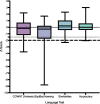Language impairments in seropositive and seronegative autoimmune encephalitis
- PMID: 38358549
- PMCID: PMC11176237
- DOI: 10.1007/s10072-024-07382-2
Language impairments in seropositive and seronegative autoimmune encephalitis
Abstract
Background and objective: Autoimmune encephalitis (AE) is a rare neuroinflammatory disease affecting the central nervous system. To examine language functions in patients with different subsets of AE consisting of seropositive and seronegative groups.
Methods: Fifty-two patients were recruited from neurology departments in Melbourne, Australia, who met clinical criteria for possible AE. Language tests include the Naming Test from the Sydney Language Battery (SydBat), the semantic fluency trial from the Controlled Oral Word Association Test (COWAT), and the Vocabulary and Similarities subtests of the Weschler Abbreviated Scale of Intelligence-Second Edition. The results were standardised with normative data.
Results: The mean age of our cohort was 52.5 years old, with the average time from hospital admission to recruitment being 38.41 months. At an aggregate level, none of the mean language test z-scores were below normative data. At the patient level, impairment rates were 18.37% for COWAT (animals), 28.57% for SydBat (naming), 4.65% for Similarities, and 4.55% for Vocabulary. Chi-squared goodness of fit tests indicated that observed performances were significantly below expected performances for the SydBat (naming) test (p < 0.0001) and COWAT (animals) (p = 0.004).
Discussion: While, on average, language functions were within normal limits in patients with AE, but a subgroup exhibited lower performance in semantic fluency and visual confrontation naming, with impairment rates below expected norms. To advance understanding of language in chronic AE patients, exploring the impact of seizure burden, antiseizure medication use, and the relationship of language functions with other cognitive functions is crucial.
Keywords: Autoimmune encephalitis; Cognition; Language; Neuroimmunology; Neuropsychology.
© 2024. The Author(s).
Conflict of interest statement
Prof. Terence O’Brien has received support from the National Health and Medical Research Council, The National Institute of Neurological Disorders and Stroke, and Monash University. He has been supported by research grants and consultancies to his institution from Eisai, UCB Pharma, Praxis Precision Medicines, BioGen, and Supernus. A/Prof. Mastura Monif has received research support from the National Health and Medical Research Council, Medical Research Future Fund, Brain Foundation, Charles and Sylvia Viertel Foundation, and MS Research Australia. MM has also been supported by research grants from Merck and Ku Leuven University, served on the advisory board for Merck, and has received speaker honoraria from Merch and Biogen. Dr. Katherine Buzzard has received speaker’s honoraria and/or conference support from Biogen, Alexion, Merck, Sanofi Genzyme, Teva, Novartis, and Roche. KB has received research grants from CSL and has served on advisory boards for Merck and Biogen. Prof. Helmut Butzkueven’s research is funded by an Australian National Health Medical Research Council Investigator Grant. His institution receives funding from Biogen, Roche, Merck, Alexion, and Novartis for speaker engagements, study steering, and advisory committee service. He is on the editorial board of Multiple Sclerosis and Related Disorders and the Steering Committee of the Brain Health Initiative (Oxford Health Policy Forum). Associate Professor Charles Malpas has received conference travel support from Merck, Novartis, and Biogen. He has received research support from the National Health and Medical Research Council, Multiple Sclerosis Research Australia, The University of Melbourne, The Royal Melbourne Hospital Neuroscience Foundation, and Dementia Australia. Associate Professor Udaya Seneviratne has received travel and speaker honoraria from Eisai Australia and LivaNova Australia. Professor Tomas Kalincik served on scientific advisory boards for Roche, Sanofi Genzyme, Novartis, Merck KGaA, and Biogen, steering committee for Brain Atrophy Initiative by Sanofi Genzyme, received conference travel support and/or speaker honoraria from WebMD Global, Novartis, Biogen, Sanofi-Genzyme, Teva, BioCSL, and Merck KGaA, and received research or educational event support from Biogen, Novartis, Genzyme, Roche, Celgene, and Merck KGaA. The remaining authors report no competing interests.
Figures

References
MeSH terms
Supplementary concepts
Grants and funding
LinkOut - more resources
Full Text Sources
Medical
Miscellaneous

